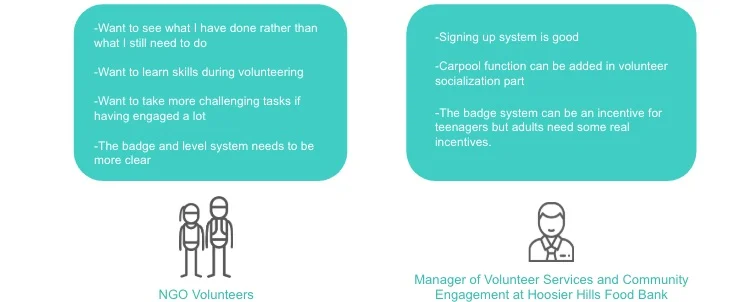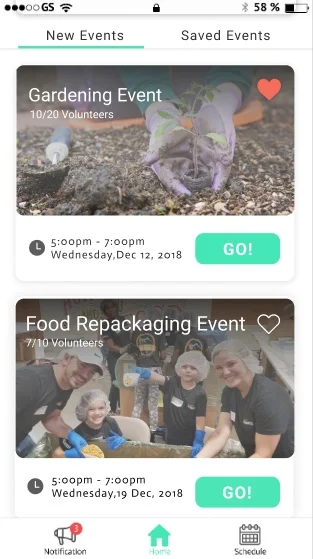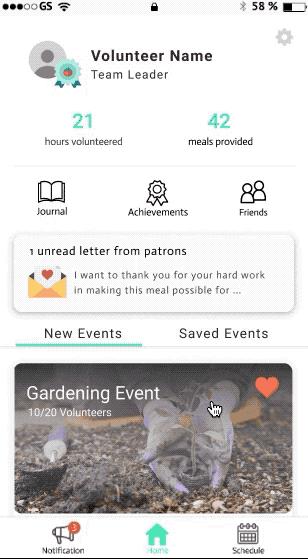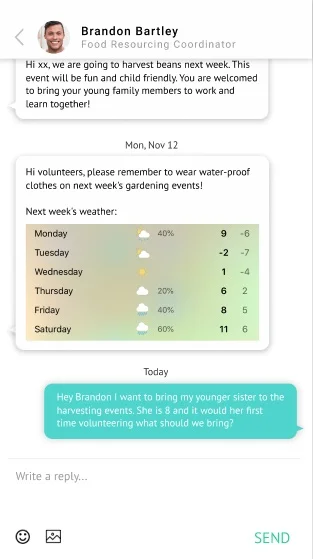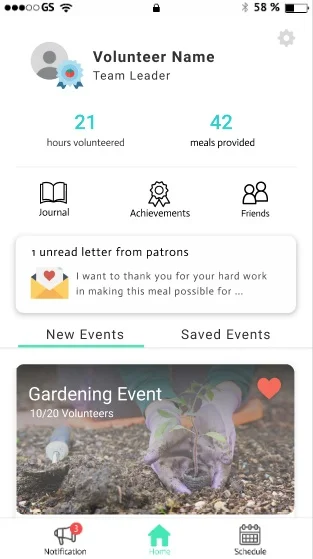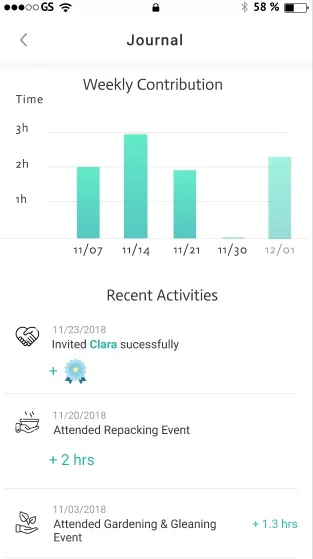Team: Clara Bradford, Ashwin Athlye, Weiyi Meng, Sihan Zha
Duration: September 2018-November2018
My Role: Interviews, Ideation, Sketching, UI, Prototyping, Evaluation
Tools: Sketch, Figma
the problem
Our challenge: “Recently, the State of Indiana formed a public-private working group to address the statewide issue of food insecurity. Government agencies, non-profits, companies, and community leaders are collaborating to improve food access across communities throughout the state, and to raise awareness about products and services available.
Food insecurity is a statewide problem with diverse stakeholders. We will have to work within the constraints of various government regulations, limited budgets, and take into account privacy and diplomacy.
IxDA is consulting with your class to conduct research discovery on food insecurity, to inform ways the firm might tackle this intractable problem. Your task will be to explore the broad issues surrounding food insecurity, and ways to tackle these challenges with design solutions.”
Although we cannot single-handedly solve this problem, how might we alleviate the issues surrounding food insecurity and access?
Research
“One in six [Americans] reports running out of food at least once a year.”
Source: https://www.nationalgeographic.com/foodfeatures/hunger/
Primary Research:
Through interviewing, observations, and diary studies with 5 different stakeholders (church employees, volunteers, food pantry, food bank) we found how each were involved in the food distribution chain. From this we gathered insights about how they affect or are affected by the issue of food insecurity.
research insights
From our research we found that there were many overlapping insights and touch points with food banks and volunteers, so we chose to focus on these stakeholders.
How did we get there?
Food Bank Needs:
The food bank that we interviewed grows their own food along with collecting donations. Though this diagram is particular to that food bank, it is similar how a typical food bank operates. We found that volunteering involves in various kinds of tasks and the efficiency of food bank work heavily relies on volunteers.
According to one of our food bank interviews 1/4-1/3 of produce from the food bank garden gets wasted because there are not enough volunteers to harvest it in time.
What stops people from volunteering?
Sense of loneliness and isolation
Feeling of marginalization in an organization
Lack of clear goals and feedback
How might we increase volunteer participation at food banks while helping them manage and retain volunteers?
Design Goal
Assist food bank with better recruiting, maintaining of, and ways to engage with volunteers.
More volunteers
=
Increased efficiency
More donations
Faster food distribution
Ideation
Storymapping: What is the volunteer experience?
Design Constraints from Insights:
The sign-up process of volunteering work happens too late before the events. They need a pre-signup method to help them predict numbers and assign volunteers tasks.
Volunteers need a tool for motivation, such as rewards, to drive them to want to volunteer again.
There needs to be a portal between the university and food bank to engage more students in volunteering opportunities
Volunteers need a way to visually see the impact of their work on the organization.
Design
View Events, Sign Up, Earn Rewards, Stay Connected
To reach these goals our application will:
Provide information needed to view and sign up for events.
Use gamification to help motivate users to sign up and invite friends to help at these events.
Foster communication between volunteers and the organization through a messaging portal.
Provide data visualization for volunteers to see the impact of their work.
Lo-Fi Prototype: Wireframes & Task flow
User Testing
We brought our lo-fi prototype to NGO volunteers and the manager at the local food bank. They confirmed the values behind our design concept and provided some valuable suggestions as follows.
Browse event information & easy event sign-up
We are designing a system that helps volunteers to not only participate in volunteering events, but also motivates them to keep volunteering.
Volunteers can browse all the events in one place. They can click and see the detail of the events and sign up easily.
Design Feature 2: Community
Upcoming Event Schedule & View Volunteer Needs for Events
On the “Schedule” tab, volunteers can first see the events they have signed up for.
The events calendar allows them to see upcoming events and how many volunteers are still needed for each event in the current month.
Inviting Friends & Carpooling System
In the event details page, users can see who is attending the event and have the option to invite their friends to attend the same event. According to our research and food bank manager’s suggestions, we added a carpool function on our second iteration. If volunteers don’t have a car, they can select the carpooling option and ride with other volunteers.
Strengthen Communication Between Food Bank & Volunteers
The notifications page allows for a channel of communication between volunteers and the food bank. Here, the food bank can send any important or last minute information to the volunteers about events they have signed up for. The volunteers are also able to communicate with the food bank if they have any questions about upcoming events.
Design Feature 3: Gamification
Level Up & Badge Incentive
With gamification our goal is to create participation and a sense of belonging among volunteers. By using “activity badges” and “leveling up” to help volunteers become motivated to gain more experience in their peripheral roles, they can then be promoted to help with core execution of events at the food bank. These badges can be achieved through attending volunteering events and inviting friends to events.
Design Feature 4: Data Visualization
Meals Provided & Journal
Along with being able to see their badges, in order to address what we saw in our findings about volunteers not being able to see their actual impact, we took to addressing this through data visualization. On the homepage volunteers are able to see how many hours they’ve volunteered and how many meals they’ve provided. The journal feature allows them to see this information in detail and their activity history.
Next Steps
We would like to do more user testing and usability testing with a wider range of age groups. We would also like to find more efficient incentives to motivate users to keep volunteering.
What I Learned
Although the issue of food insecurity cannot be completely resolved with one design solution, we can tackle certain angles of the problem that help alleviate the issue. I felt that the various research methods we used really allowed us to get a broad overview of our design space. These research methods gave us a wide range of insights that helped us look at the stakeholders from various angles and then decide at which angle we wanted to approach the design space.





